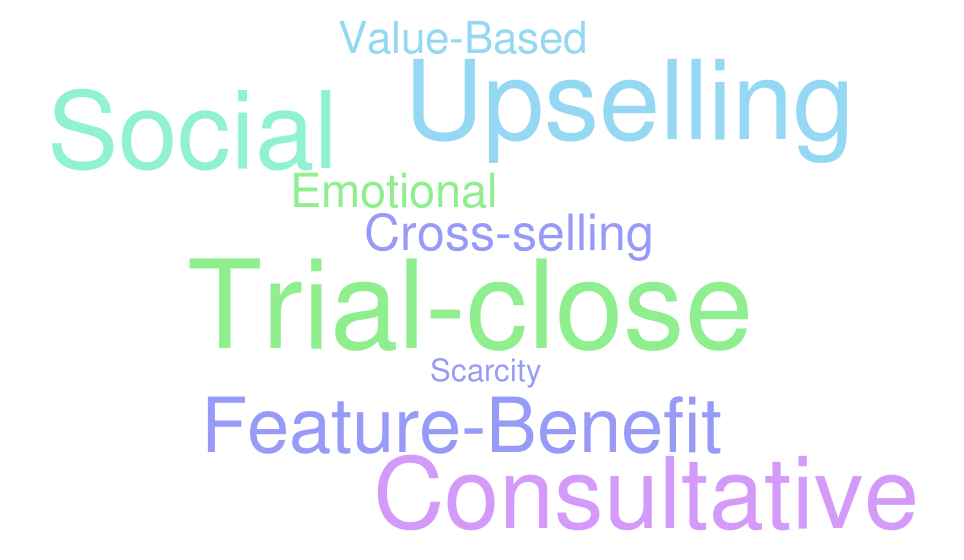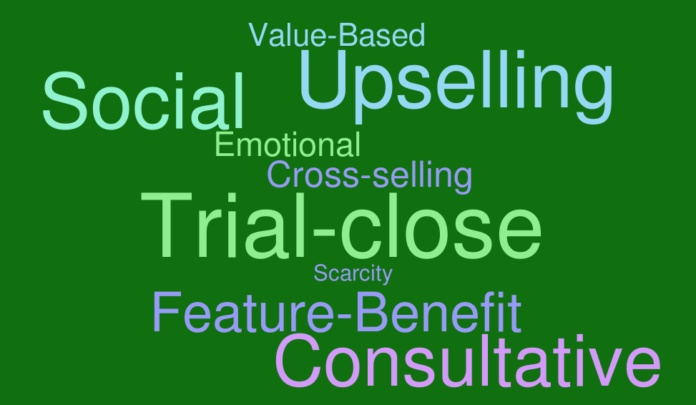Table of Contents
Effective sales techniques are essential for businesses to successfully sell their products or services in today’s competitive market. While there are countless techniques and approaches to selling, the most effective ones often focus on building strong relationships with customers, understanding their unique needs and pain points, and offering tailored solutions that meet their specific challenges. By mastering these skills, businesses and sales professionals can improve their sales outcomes and drive growth.
Top 10 Effective Sales Techniques
From consultative selling and solution selling to feature-benefit selling and value-based selling, there are a variety of techniques that sales professionals can use to persuade potential customers to make a purchase. In this article, we will explore some of the most effective sales techniques and how they can be applied to different industries and products.

Feature-Benefit Selling
Feature-benefit selling is a popular technique used by sales professionals to showcase the benefits of their products or services. This technique emphasizes the unique features of the product and how it can solve a customer’s problem or meet their needs. The focus is on how the product can provide value to the customer rather than simply listing its features.
To use feature-benefit selling effectively, it is essential to understand your customer’s needs and pain points. By understanding what the customer is looking for, you can tailor your message to highlight the features that are most relevant to them.
For example, if you are selling a car, you might highlight its fuel efficiency as a key feature. To do this effectively, you need to understand the customer’s pain point, which in this case could be the rising cost of gas. You can then explain how the car’s fuel efficiency can save the customer money on gas, making it a more economical option in the long run.
It’s important to note that simply listing features is not enough to persuade a customer to make a purchase. Instead, you must connect the features of the product to the benefits it can provide to the customer. This means explaining how each feature can make the customer’s life easier, better, or more enjoyable.
Consultative Selling
Consultative selling is a customer-focused approach that emphasizes building relationships and understanding the needs of the customer before offering a solution. This technique is effective because it helps you establish trust with the customer and positions them as a valuable resource.
The consultative selling process typically involves several steps. The first step is to build rapport with the customer and establish a relationship. This can involve asking questions about their business, their challenges, and their goals. You should be genuinely interested in the customer’s business and should focus on building a long-term relationship rather than just making a sale.
Once rapport has been established, you can start to ask more targeted questions to better understand the customer’s needs and pain points. This might involve asking about their current processes, identifying areas where they are experiencing challenges, and exploring their goals for the future.
Once you have a good understanding of the customer’s needs, they can start to offer solutions that address those needs. This might involve presenting different options and explaining how each one could help the customer achieve their goals. The salesperson should be prepared to answer any questions the customer may have and provide examples of how their solution has worked for other customers.
One of the key advantages of consultative selling is that it positions you as a trusted advisor rather than a pushy salesperson. This can help to build a long-term relationship with the customer and increase the likelihood of repeat business.
Another benefit of consultative selling is that it can help you to identify new opportunities for business. By understanding the customer’s needs and pain points, you can identify other products or services that might be of interest to them and offer additional solutions that could help them achieve their goals.
Solution Selling
Solution selling is not just about pushing your product or service onto the customer. It’s about understanding their pain points, challenges, and goals and providing a customized solution that meets their specific needs. This approach requires a deep understanding of your target market and the ability to effectively communicate the benefits of your product in a way that resonates with them.
One of the key elements of solution selling is active listening. This involves asking open-ended questions and really listening to the customer’s responses. By doing so, you can gain a better understanding of their needs and tailor your solution accordingly. Active listening also helps build trust and credibility with the customer, which is essential in any sales relationship.
Another important aspect of solution selling is the ability to highlight the features and benefits of your product in a way that resonates with the customer. This involves identifying the specific pain points or challenges that the customer is facing and demonstrating how your product can address those challenges. It’s not enough to simply list the features of your product. You need to explain how those features provide a solution to the customer’s problem.
For example, if you are selling a software solution to a small business owner, you might ask them about their current processes for managing inventory and tracking sales. Based on their responses, you can demonstrate how your software can streamline those processes, saving them time and increasing their efficiency. You might also highlight how the software provides real-time data and reporting, which can help them make better-informed decisions.
Social Selling
Social selling is a technique that involves using social media platforms to connect with potential customers and build relationships with them. It’s all about leveraging social media to create a sense of trust and loyalty with your followers. To do this effectively, you need to create and share valuable content, engage with your followers, and offer personalized solutions.
For example, if you are a B2B company, you might use LinkedIn to connect with potential customers in your industry. You can share relevant content, such as industry news or helpful tips, and engage with your followers by commenting on their posts or sharing their content. You can also offer personalized solutions by messaging potential customers and offering to help solve their specific challenges.
Value-Based Selling
Value-based selling is a technique that involves emphasizing the value that your product or service can provide to the customer. It’s all about showing how your product can save them time, and money, or improve their quality of life. To do this effectively, you need to understand the customer’s priorities and demonstrate how your product aligns with them.
For example, if you are selling a cleaning service, you might highlight how it can save the customer time and allow them to focus on other tasks. You might also emphasize how a clean and organized space can improve their mental health and overall quality of life. By emphasizing these value propositions, you can convince the customer that your product is worth the investment.
Upselling
Upselling is a technique that involves suggesting additional products or services to a customer who has already made a purchase. By offering complementary or upgraded products, you can increase the customer’s total spending and boost your revenue. For example, if you are selling a camera, you might suggest additional lenses or accessories enhance the customer’s photography experience.
One of the keys to effective upselling is to make sure that the additional products or services you suggest are relevant to the customer’s needs and interests. For example, if the customer has already purchased a camera, suggesting a tripod or a camera bag might be more relevant than suggesting a new phone case.
Another critical factor is timing. It’s important to suggest upsells after the customer has already committed to the initial purchase. This way, they are already in a buying mindset and may be more receptive to additional suggestions.
Cross-selling
Cross-selling is a technique that involves suggesting related products or services to a customer who is already interested in your product. By showing them how these related products can enhance their experience, you can convince them to make additional purchases. For example, if you are selling a phone, you might suggest a phone case or screen protector to protect their investment.
Like with upselling, the key to effective cross-selling is relevance. You want to suggest products that are related to the customer’s initial purchase and will enhance their experience. For example, if the customer is buying a phone, suggesting a phone case or screen protector is relevant and useful.
Timing is also important with cross-selling. You want to suggest related products at a time when the customer is already engaged and interested. For example, if the customer is browsing phone cases, suggesting a screen protector at that time may be more effective than suggesting it later in the sales process.
Trial Close
A trial close is a technique that involves asking a customer for their opinion or commitment during the sales process to gauge their interest level. By asking questions like “How do you feel about this so far?” or “Would you like to proceed with this purchase?” you can get a better sense of whether the customer is likely to buy. For example, if you are selling a subscription service, you might ask the customer if they would like to sign up for a free trial.
Trial close questions can help you gauge the customer’s level of interest and address any concerns they may have before the final close. If the customer seems hesitant or unsure, you can address their concerns and provide additional information to help them make a decision.
Scarcity Selling
Scarcity selling is a technique that involves creating a sense of urgency or scarcity around your product or service to encourage customers to make a purchase. By emphasizing limited availability, time-limited discounts, or the risk of missing out, you can create a sense of urgency that can lead to sales.
One of the most effective ways to use scarcity selling is by highlighting limited availability. For example, you might tell customers that there are only a few units of a product left in stock, or that a sale will end soon. By doing so, you create a sense of urgency and encourage customers to act quickly.
Another way to use scarcity selling is by offering time-limited discounts. For example, you might offer a discount that is only available for a certain period, such as 24 hours. By doing so, you encourage customers to act quickly to take advantage of the offer.
Scarcity selling can also be effective by highlighting the risk of missing out. For example, you might tell customers that a product is in high demand and likely to sell out soon. By doing so, you create a fear of missing out (FOMO) that can motivate customers to make a purchase.
Emotional Selling
Emotional selling is a technique that involves appealing to the customer’s emotions to persuade them to make a purchase. By using storytelling, humor, or other emotional triggers, you can create a connection with the customer that can lead to a sale.
One way to use emotional selling is by telling a story that resonates with the customer. For example, you might tell the story of how your product or service has helped a previous customer overcome a challenge or achieve a goal. By doing so, you create a connection with the customer and demonstrate the value of your product or service.
Humor can also be an effective emotional trigger. By using humor, you can create a positive association with your product or service that can make customers more likely to make a purchase.
Another way to use emotional selling is by creating a sense of urgency around the customer’s pain points. For example, if you are selling a product that helps people lose weight, you might highlight the negative emotions associated with being overweight, such as low self-esteem or lack of confidence. By doing so, you create a sense of urgency and motivate customers to take action to address their pain points.
How Digital Marketing Complements Effective Sales Techniques

Digital marketing can be a powerful tool for implementing effective sales techniques. By leveraging online channels such as social media, email marketing, search engine optimization, and content marketing, businesses can reach a wider audience and build relationships with potential customers.
For example, social media platforms such as LinkedIn, Facebook, and Twitter can be used to connect with potential customers and share valuable content that highlights your product or service. Email marketing can be used to nurture leads and provide personalized solutions to specific pain points. Search engine optimization (SEO) can help your website rank higher in search results and drive more traffic to your site, increasing the chances of converting visitors into customers.
Content marketing, such as creating informative blog posts or videos, can establish your business as a thought leader in your industry and showcase the benefits of your product or service. These digital marketing strategies can complement traditional sales techniques, providing a broader reach and helping to generate more leads.
Incorporating digital marketing into your sales strategy can be a highly effective way to increase your sales and grow your business. If you’re interested in learning more about how digital marketing can help your sales techniques, consult with a digital marketing professional or agency to develop a tailored strategy that meets your business’s unique needs.
As you explore effective sales techniques and the role of digital marketing in supporting them, you may find that partnering with a digital marketing agency can help take your sales strategy to the next level. If you’re interested in exploring this option further, click here to learn more about our digital marketing services and how we can support your sales efforts.
Advantages of Familiarizing Yourself with Effective Sales Techniques
Sales techniques are essential for any business to succeed in today’s competitive market. By understanding your customers’ needs and pain points, and using the right approach, you can convince them to choose your product or service over others. Whether it’s consultative selling, feature-benefit selling, solution selling, social selling, or any of the techniques on this list, mastering these techniques can help you build strong relationships with customers and increase your sales.
Remember to stay informed and adaptable, as sales techniques evolve with changing customer behaviors and market trends. With the right skills and strategies in place, you can successfully grow your business and achieve your financial goals.
Now that you have learned about different effective sales techniques, it’s time to put them into action. What sales techniques do you use in your own sales approach? Share this article with someone who could benefit from these techniques, and let us know your most preferred technique in the comments below. Don’t forget to keep learning and refining your skills to become an even more successful sales professional.













